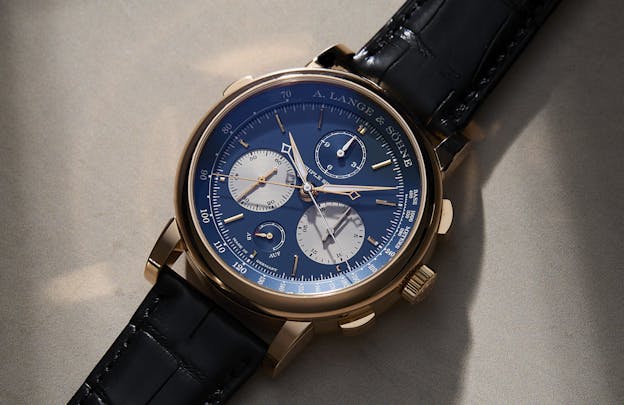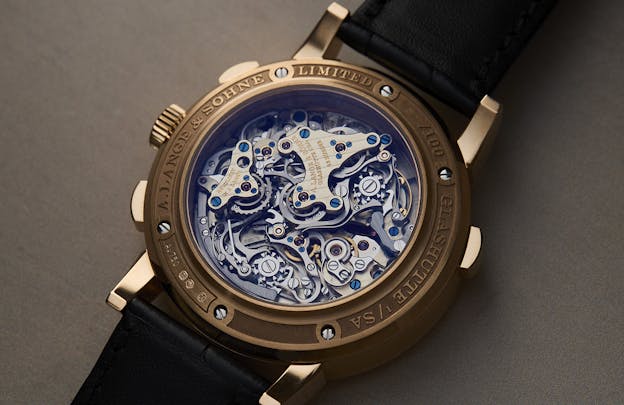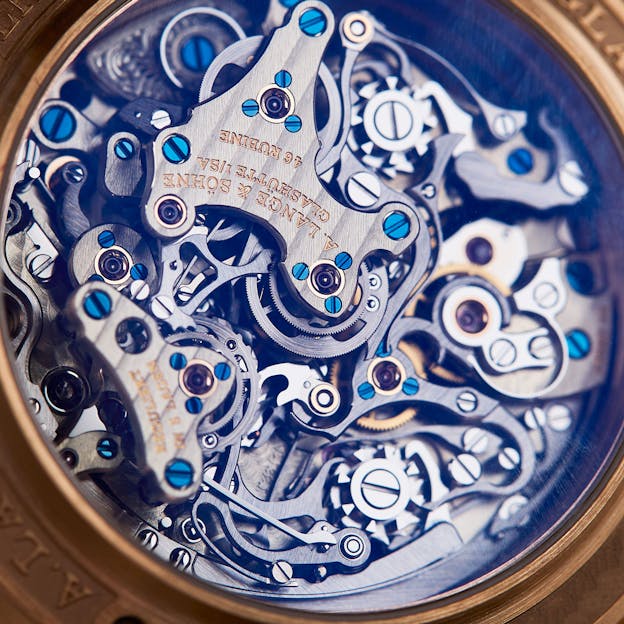A Watch A Week: An A Lange & Söhne Triple Split Limited Edition
The split to end all splits.
In 2004, A. Lange & Söhne released a remarkable watch that was not just a ten-day wonder – over 20 years later, the Double Split remains one of the most intricate, ingenious, and beautiful chronograph wristwatches ever produced. The Double Split was a rare example of a true first in watchmaking: a rattrapante chronograph which could provide split times for both the seconds and the minutes. All other rattrapante chronographs can provide split times for up to sixty seconds’ difference between the first and second time inerval, but the Double Split provided a split minutes as well, allowing for up to an hour’s difference between two timing periods. At that point I think everyone pretty much thought that Lange had done just about everything you can in terms of extending the practical usage of a rattrapante chronograph, which is, even in its standard form, sufficiently difficult to make and adjust that it’s considered one of the three classic high complications (the other two are the minute repeater and the perpetual calendar; all three of these make up a traditional “grand complication” although the term is used a little more loosely nowadays).
However, Lange wasn’t done. A Double Split naturally raises the question of whether or not it would be possible to make a watch with a split hours as well, and while I think the entire collector community took it for granted that the question would remain a hypothetical one, Lange took the problem under serious consideration. Finally, in 2018, Lange launched a watch which was a technical triumph and which gave the collector community much to chew on, both in terms of horological content, and in terms of philosophical challenges. That watch was the A. Lange & Söhne Triple Split, one of which – a limited edition in pink gold with a blue dial, and which was released in 2021 – is featured in today’s edition of A Watch A Week.

I should say at the outset that this is a large, heavy watch which is certainly not likely to be a daily driver, although exceptional tastes in watches sometimes come with exceptional opportunities to live on a daily basis with extremely complex timepieces. The Triple Split is essentially a three register chronograph, but of course, with split hands for the minutes and hours as well as the seconds. There’s a power reserve indicator (“Auf Ab” or “up down”) at 6:00 and despite its size, the Triple Split is from a design standpoint an absolutely classic piece of watchmaking. Put it in a pocket watch case and you wouldn’t be surprised to find it as a showpiece from Lange 1n 1918 instead of 2018. The only exception from a dial design and cosmetics standpoint is that there is actually lume on the gold hands and at the dial quarters, although not nearly enough to be noticeable as an aberration from what is basically a pocket-watch derived dial. There’s also a tachymeter scale calibrated for average speed over a kilometer’s distance, although like all tachymeter scales it can be used as a more general units-per-hour measurement device as well.


As with all Lange watches, fit and finish of the case, hands, and dial furniture is excellent and almost forbiddingly precise, so much so that with some Lange watches – particularly in platinum – you could feel like you have your work cut out for you living up to the watch. That said, there’s nothing especially ostentatious about the Triple Split other than, perhaps, the sheer amount of gold involved, but the construction details of the case, crown and lugs are absolutely topnotch (as you’d expect from a Lange flagship complication, although the company is famous for paying just as much attention to detail in the cases and dial furniture of its simpler watches as well). The chronograph pushes and lugs have very finely polished bezels and the lugs have been made as separate components, which are then welded into recesses in the case, allowing for an extremely crisp transition as well as a seamless continuation of the case middle brushing.

As is usually the case with Lange, it’s business in the front and party in the back, and what a party it is.

The case for the Triple Split is 43.2mm in diameter and 16.1mm thick, but the Lange caliber L132.1 fills it up as beautifully as a movment has ever filled a watch case. Just about everything visible through the caseback is part of the chronograph mechanism, which in addition to the triple split complication, is also a flyback chronograph; when you look at the complexity on display it’s not hard to believe that there are 567 components in the movement. Despite the complexity, this is not a ponderously large movement – at 30.6mm x 9.4mm, it’s actually quite compact considering the parts count and over-the-top functionality; 30mm is, more or less, the maximum diameter of what would be classically be considered a wristwatch movement (at least in terms of the rules for the observatory chronometer competitions, where 30mm was the maximum size allowed in the wristwatch category). And, amazingly enough, it’s only 0.3mm thicker than the caliber L001.1 in the Double Split, while at the same time offering a 55 hour power reserve, versus the 38 hour power reserve of the Double Split.

One major feature of both the Double and Triple Split watches is the use of isolator mechanisms for the split seconds mechanisms. A rattrapante chronograph has sets of superimposed hands – just one pair in a conventional rattrapante, but two (seconds and minutes) in the Double Split, and three (seconds, minutes, and hours) in the Triple Split. The seconds hands run together, with one hand on a hollow pipe, and the other on a pivot inside. One hand is mounted on a heart shaped cam, identical to a standard chronograph reset-t0-zero cam, and the two hands rotate together thanks to a ruby roller or a ruby hammer face which presses on the lowest point of the cam, holding the split hand in position. When the hands are split, the wheel for one of the hands is immobilized, but the other continues to turn – and the roller or hammer face therefore ride over the outside of the cam as the moving hand continues to turn, which exerts pressure on the cam that varies as the cam turns. Press the split seconds button again, and the immobilized wheel is free to turn, and under the pressure of the hammer or roller against the cam, the cam rotates until the two hands are once again superimposed and running together.
It’s a clever mechanism but highly sensitive to improper adjustment; if the return spring for the hammer or roller is even slightly too weak, the hands will not re-synchronize properly but if it’s even slightly too strong, the pressure of the roller or hammer against the cam will take up too much torque from the mainspring, and balance amplitude will start to fall. To prevent this, Lange uses an isolator system which, when the chronograph hands are split, lifts the reset hammer off the cam; the wheel is held in position until the split button is pressed again, at which point the immobilized chronograph wheel is free once again to turn. At the same time, the hammer falls into position and the split hands are synchronized.

The isolator has an important role to play even in a standard rattrapante chronograph, but with two or three split hands, the problem of drag on the reset cams and loss of amplitude becomes even more acute and the isolator becomes even more necessary. The use of isolator systems in both the Double and Triple Split watches is an essential ingredient in their reliable functioning.
And, as we mentioned, the Double and Triple Split are both flyback chronographs, which extends to the split hands as well; if you push the reset pusher while the hands are split you’ll have the brief but exciting spectacle of seeing three pairs of hands all fly back to the zero position simultaneously.

I said at the outset that the Triple Split presented some philosophical questions to the enthusiast community, which can all basically be boiled down to whether or not, as longtime collector GaryG put it, the Triple Split was “one split too many.” In one sense of course, the Triple Split is absurd, but in another sense it represents a very specific kind of watchmaking, and one honored across the entire five hundred year history of watchmaking, which is the tradition of making watches which are demonstrations of just how far you can take mechanical complexity as a source of interest and entertainment in and of itself.
There is an clock in the British Museum, made for the Elector of Saxony in 1585, which is shaped like a galleon and which in addition to telling the time, could also move across a banquet table under its own power, with trumpets blaring and miniature cannons firing; this is similar in spirit to much later exercises in mechanical wizardry as a goal and which includes complications up to and including things like the Graves Supercomplication. It’s a fascinating watch and a magnificent showpiece as well as being a true first – but I have to admit, I’m still waiting for a Quadruple Split Perpetual calendar, which can split the seconds, minutes, hours, date, month, and year in accordance with the rules of the Gregorian calendar. The Sextuple Split Perpetual Calendar: It might be a long wait.
See the Lange Triple Split here, and contact the 1916 Company for pricing and availability.

